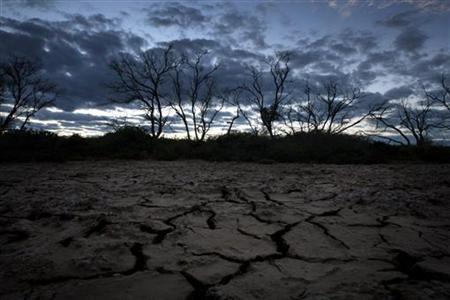Date: 05-Feb-09
Country: AUSTRALIA
Author: Michael Perry
Indian Ocean Linked To Australian Droughts Photo: Tim Wimborne

The early morning sky illuminates dead trees and cracked
earth on a farm near Kerang, about 360km (224miles) north of Melbourne,
August 24, 2007.
Photo: Tim Wimborne
SYDNEY - Droughts in Australia have traditionally been linked to El Nino
events in the Pacific Ocean, but a new study says the key driver of major
droughts has been a warming and cooling cycle in the Indian Ocean.
The research shows Australia's major droughts over the past 120 years,
including the Federation drought (1895-1902), the World War Two drought
(1937-1945), and the present drought (post-1995), all coincide with
fluctuations in ocean temperature known as the Indian Ocean Dipole (IOD).
Researchers from the University of New South Wales (UNSW) say their study
explains why a series of La Nina weather events, which usually bring Pacific
rains to Australia, have failed to break the current drought, the worst in
100 years.
When the IOD is in a negative phase it creates cool Indian Ocean water west
of Australia and warm Timor Sea water to the north. This generates winds
that pick up moisture from the ocean and sweep across southern Australia,
delivering wet conditions.
In a positive phase, the pattern of Indian Ocean temperatures is reversed,
weakening the winds and reducing the amount of moisture picked up and
transported across Australia, said the study to be published in Geophysical
Research Letters.
"What we have found is that there has not been a single wet event, not a
single negative event in the Indian Ocean Dipole since 1992," said Caroline
Ummenhofer from the UNSW Climate Change Research Center, who led the
research.
"That means all you are left with in southeast Australia is dry events. The
cause of the "Big Dry," the current drought, is actually due to a lack of
negative Indian Ocean Dipole events that remove the wet years from southeast
Australia."
Dipole events tend to last for about six months and it was unclear if there
would be another positive event this year.
There have been positive IODs for the past three years.
"In a few months' time it will be more certain if there is an Indian Ocean
Dipole event is occurring (in 2009)," said Ummenhofer.
KEY DROUGHT DRIVER
Traditionally, scientists have linked El Nino events in the Pacific Ocean
with Australian droughts.
El Nino occurs when the eastern Pacific Ocean heats up, with warmer, moist
weather moving toward the east, leaving drier weather in the western Pacific
and Australia.
La Nina occurs when the eastern Pacific Ocean cools, leaving the western
Pacific warmer and increasing the chance of wetter conditions over
Australia.
The researchers compared the IOD and La Nina and El Nino events and droughts
between 1889 and 2006 and found positive IODs matched major droughts.
"We have shown that the state of the Indian Ocean is highly important for
rainfall and droughts in southeast Australia, more than the variability
associated with the El Nino/La Nina cycle in the Pacific Ocean," said
Ummenhofer in a briefing on the study.
"The Indian Ocean Dipole is the key factor for driving major southeast
Australian droughts over the past 120 years."
The researchers said more study was needed to pinpoint the cause of IODs,
with half linked to La Nina events in the Pacific and the other half
dependent purely on the Indian Ocean.
"The Indian Ocean is the least studied and therefore it's a lot less
clear...what sets off these events," said Ummenhofer.
But the researchers said the IOD, like El Nino and La Nina, was predictable
three to six months out. Indian Ocean Dipole events usually appear around
May, June and peak in September to November.
"There are some indications that positive Indian Ocean Dipole are becoming
more frequent and negative events less frequent. However, this needs to
further investigation."
(Editing by David Fogarty)
© Thomson Reuters 2009 All rights reserved
